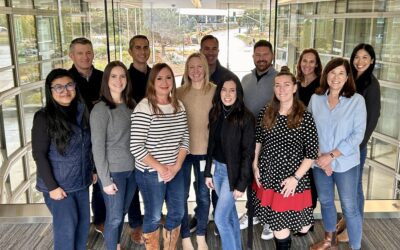As leaders, we’re always navigating change from a variety of sources. Complex cultural and sociopolitical topics continue to impact work and personal lives, while attempts to return to “normalcy” seem to be anything but normal. Meanwhile technology continues evolving, bringing both promises and potential threats.
Amid disruption and economic shifts, many people are navigating massive layoffs; many also struggle to find the best way to approach connecting and returning to in-person work life. How do we find ways to thrive and influence as leaders in such dynamic times? How do we empower our employees to become better at leading people, no matter what comes their way?
Despite the continuously changing world, there are three tenets of leadership development that have withstood the test of time:
- Leaders embrace development.
- Leaders create meaning.
- Leaders overcome obstacles.
Great leaders bring out the best in people because they understand how they influence and are influenced by other people. They’re critical in bringing strategy to life. They’re key to business transformation. Ideally, great leaders who own their role in leading others can be found at all levels of your organization—from frontline managers to executives.
No matter where you find yourself leading, taking action on these three tenets is critical for your effectiveness in leading others and supporting the organization’s structures and systems. Embracing development, creating meaning, and overcoming obstacles will all serve to help you thrive amid the issues we face as leaders. Let’s dig into these three leadership development tenets.
1. Modern leaders embrace development
Great modern leaders actively seek growth opportunities and take time to reflect on their strengths and areas of development. They attend workshops, take assessments, meet with mentors, and seek feedback from others. By developing themselves, they better understand how they show up at work to lead. They also stay on top of the trends that may help or hurt their businesses. Having said that, they can’t know everything—and may rely on their team to explore trends.
These leaders can trust in and depend on their team because, as a leader, they also embrace the continuous development of others. They strive to know the people on their team as individuals, asking:
- What makes my team member tick?
- What are they currently seeking in their career?
- What areas can they develop to reach their full potential?
- How can we help them put their strengths into action even more?
- What role can I, as the leader, play in their development?
Keeping this tenet of leadership development top of mind can be overwhelming. That’s why we recommend not only capturing employee performance data and feedback for development opportunities, but also creating a visual dashboard that showcases progress in a personalized way (or even for the team).
The best leaders encourage a growth mindset in their team. They model what a growth mindset looks like, and they recognize and reward employees who continually find opportunities to develop themselves and others. Time-based communication and nudges can provide reminders to prioritize development and actionable insights that support a growth mindset. Systems for badging, social community, and certifications are also powerful for sustaining growth and development (and can add some friendly competition).
Consider: We recognize that you need space (and sometimes permission) to prioritize your development. What cultural norms might exist in your organization that prevent leaders from embracing development? What conversations might you need to have so your development is not only allowed but encouraged? (To dig deeper into your personal development, check out The Importance of Learning to Load Share as a Leader.)
2. Modern leaders create meaning
Simply put, everybody has to know why they matter. It’s what motivates many of us to get involved and participate in what we’re being asked to do. When we know our hard work is valued or contributes to a meaningful impact, we work harder.
Leaders are crucial for communicating how employees fit into the bigger picture. It’s important for any team to understand its collective role in driving desired business results. Effective modern leaders articulate the value that their team brings to the organization. They also inspire team members to stay in the game when the going gets tough. This means, if the game massively shifts (e.g., layoffs), team members can tell the story of the value they brought and the impact they had, no matter where they go.
It’s especially critical for leaders to create meaning during times of change. Leaders are on the receiving end of a lot of input for change—senior leadership, the market, their team, the customer. How they receive and communicate that information to their team has a huge impact on employees’ ability to succeed and thrive in the new normal at work.
Consider: Leaders don’t exist in a vacuum—their messages and actions (or lack thereof) typically are viewed within the context of the organization’s broader story, meaning there can be a ripple effect. Often leaders are asked to connect the dots from the work their team is doing to the company’s mission, vision, and values. Are you balancing being asked to say one thing and do another? Is the organization articulating and modeling the same values that you’re being asked to champion? Are you equipped with the necessary knowledge to be a catalyst for the business? (For related insights, check out Conscious Leadership Requires Understanding the Impacts of Your Decisions.)
3. Modern leaders reframe obstacles
Have you ever seen a leader put pressure or strain on a situation? A challenging situation arises with obstacles that need to be addressed, and the leader stokes fires through their communication. Rather than seeking to understand and improve, they can come off as accusatory and blaming. Frankly, it isn’t very productive and can even cause drama.
To diffuse tension and stress, leaders must reframe the obstacle ahead as a challenge that can be overcome. When faced with obstacles, effective modern leaders engage others in meaningful conversations and interactions. To help them reframe the challenge, they focus on three things:
- Asking the right questions
- Actively listening to others
- Respectfully challenging ideas to draw out better thinking
Facilitating quality conversations involves more than strong communication skills. Being curious, empathetic, and growth-oriented also serves the leader well when reframing obstacles. They will also need to understand business financials so that they can make strategic decisions and form valuable partnerships. If leaders know how to juggle working in a hands-on manner versus stepping back to think big picture, they’ll be able to transform obstacles facing their team into development opportunities.
Consider: Some leaders struggle to hold meaningful conversations that reframe obstacles as challenges. And changing mindsets and behavior is hard work—memorizing a checklist of policies won’t adequately equip leaders to have better conversations. What guiding principles or behaviors guide your day-to-day conversations and interactions? What needs, if they were met, would support you or your team in embracing obstacles? (To learn more about reframing obstacles, check out Why Leaders Should Embrace Adaptive Change to Achieve Better Outcomes.)
Trends of modern leadership
Now that we’ve covered the three leadership development tenets that continue to help leaders thrive in a dynamic environment, let’s turn our attention to some modern leadership trends. Over the years working within the leadership development space with our clients, several trends have emerged.
Click the button to download a factsheet of emerging trends for leadership development.
Trend #1. Integrating innovative leadership approaches into current and outdated programs
Key finding: Increase your emphasis on agility, transformational leadership, and empathy
Related findings:
- Focus on the employee experience
- Connect employees to a purpose
- Create clarity around career pathing and succession planning
- Use personas to create meaningful experiences
Trend #2. Prioritizing how leaders communicate and integrating leadership into the organization
Key finding: Take time to understand your audience so that your communication is clear and concise
Related findings:
- Use storytelling
- Meet people where they are
- Be open about honest mistakes and maintain trust
- Know which information the audience values
Trend #3. New considerations for a dynamic environment
Key finding: Place greater emphasis on unity, equity, safety, empathy, and trust in leadership
Related findings:
- Embrace trauma-informed leadership
- Treat your employees first as human beings with emotional needs and support them on an emotional level
- Consider your role in creating both physical and psychological safety
- Clearly communicate and be open in your decision-making
Trend #4. Increasing need to reach the Gen Z workforce
Key finding: Focus on concise and clear communication embedded within ways of working
Related findings:
- Leverage multiple methods of communication (digital natives rely on apps but prefer face-to-face conversations)
- Retain attention with concise messaging and visual communication
- Know where the organization stands regarding work-life balance, flexibility, and pay (Gen Z is seeking a modern, transparent, and entrepreneurial workforce)
Trend #5. A rise in human-centered leadership within all levels, roles, and industries
Key finding: Unlearn basic management, relearn focusing on being people first
Related findings:
- Connect with empathy, lead with compassion
- Embrace your courage over your comfort
- Know that being direct is faster and clarity is kindness
- Help others and be generous
- Take care of yourself so you can care for others (“put on your oxygen mask first”)
About the Author
Jeremy Goebel is a Principal Consultant at TiER1 who serves as the Delivery Director of the Procter & Gamble team. He’s passionate about developing leaders, transforming cultures, and having lots of fun along the way. Jeremy enjoys crafting learning experiences that both engage and inspire participants, using empathy to create relevant learning solutions that provoke meaningful and lasting change.
Kerri Chik is an Industrial Organizational Scientist at TiER1 who loves finding innovative, sound solutions to all types of cool problems and research questions. Kerri specializes in leadership and team development, performance measurement, data analysis, and instructional design. Other passions include yoga and behavioral statistics.




